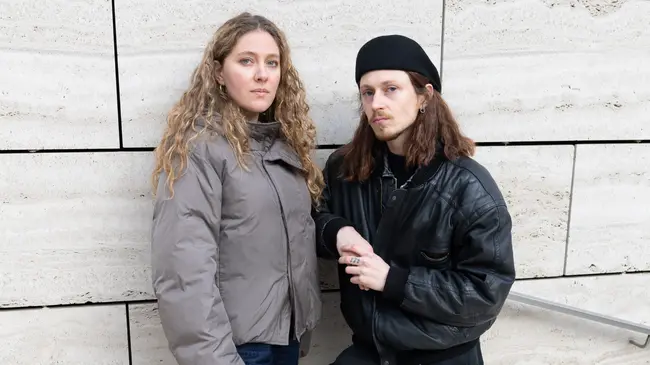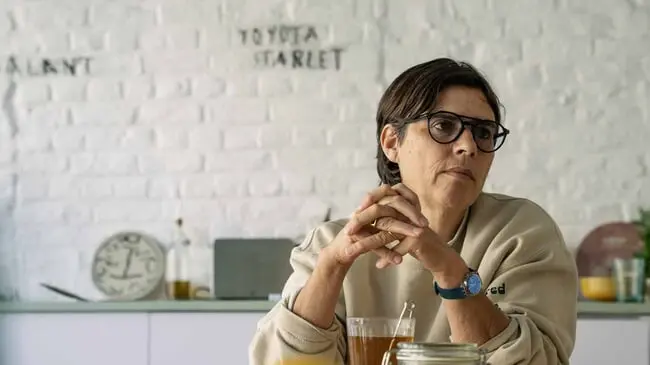The future and the past

Recent KASK alumni Fatemeh Khezri is interested in combining the traditional with the futuristic. With a background in calligraphy, Fatemeh’s recent work introduces a unique style of pixel painting, referencing video games in their aesthetic and folklore in their content. Her master project, Perpetual Other, records her own version of history, sharing stories from Afghan refugees and providing a space to process.
In what ways was your practice influenced by the multidisciplinary community in the autonomous design masters at KASK?
My bachelor's degree is in architecture. However, my artistic background started with calligraphy. My curiosity for geometry and details has always been fundamental to my practice, but I was very lost when I started architecture. I didn't know about the Autonomous Design program until some friends of mine suggested that I try it. I liked that the course was very open, people in our studio did so many different things so it was a creative and inspiring environment.
<img class="editorial-image-50-left" src="https://cdn.prod.website-files.com/61eebcc683107b99137f4423/66db11ebde30f722dc3044e3_differentclassDifferent%20Class-11.webp"/>
<img class="editorial-image-50-right" src="https://cdn.prod.website-files.com/61eebcc683107b99137f4423/66db11d12ed75909b7aa52b9_differentclassDifferent%20Class-10.webp"/>
How did you find your way from calligraphy to your current style of pixel painting?
My practice started with the study of calligraphy. You cannot go to a university or request to learn it, because it depends on the experience of living together with masters, living in the art. I learned so many other things than calligraphy from that experience. From this perspective, I have respect for the traditional way of learning. In Islamic calligraphy, you use a bamboo pen and when you sharpen the pen it has a flat head. The scale in that work is actually a dot, so my pixel paintings are similar, as they are measured in squares.
<img class="editorial-image" src="https://cdn.prod.website-files.com/61eebcc683107b99137f4423/66db11d10bde70b22f530dd1_differentclassDifferent%20Class-12.webp"/>
Tell me about your master project: Perpetual Other.
The project is an audio-visual installation, featuring a burqa helmet in the middle accompanied by pixelated paintings in four different parts. It is an immersive storytelling device designed to blur the lines between the storyteller and the audience. If I want to explain the project, I think I have to start by explaining the title. This title typically refers to a group or an individual that's considered different, outside the norm, or ‘alien.’ This status of being other is not temporary, it contributes to a sense of exclusion or marginalisation. At the time, I was completing an internship at Reno, a refugee camp in Ghent. While I was there, I had the chance to speak with Afghan refugees in my own language. This was my first encounter with Afghan refugees outside of Iran and in a different context.
The project is an audio-visual installation, featuring a burqa helmet in the middle accompanied by pixelated paintings in four different parts
I started to realise that their experience is so different from what I had always known, in large part because of the influence of media and racism and xenophobia in my country against Afghan refugees. I began to interview the refugees with a simple question, ‘What is Afghanistan like?’ Everyone approached the question in different ways, from drawing a map to sharing a memory or telling a story. With this collection of audio files, I began creating some paintings. This made me think about the value of traditional oral storytelling in Afghanistan. In this tradition, stories that originated so long ago certainly carry information from the past, but they are also adaptable, changing with every different person who shares them. I think that is what makes the stories alive.
What is Afghanistan like?’ Everyone approached the question in different ways
<img class="editorial-image" src="https://cdn.prod.website-files.com/61eebcc683107b99137f4423/66db11d0b27c57719ca2b393_differentclassDifferent%20Class-19.webp"/>
The digital aesthetic is reminiscent of video game design and other fantasy world-building, how does this visual language contribute to your larger themes of displacement, space, and belonging?
I like this look of the future. What I'm doing is basically writing a story. We already know that so much of recorded history is not true, so it doesn't have to be completely accurate, because who can say what is accurate to any one person’s experience? I thought that I would like to write a new history that shows the future of Afghanistan on a freeway. For example, one of the recordings is a story of an angel who is in love with a shepherd, and when I visualised that woman, I saw her as very free, with long hair, without a burqa, just being in nature and being one with nature.
For me, it feels important to have this futuristic look because this is the history of the future. The paintings also look like a video game. I was thinking of how in many games, you start somewhere unknown, and then you find your way back home. This feels important to the history of Afghanistan and how many Afghan people were once nomadic, and displacement is actually a part of their heritage.
I like this look of the future
Tell me about the helmet element of the work.
When you wear the helmet you are limited, so I called it a burqa helmet. It limits your vision and your movements but plays recorded stories of Afghanistan. I also called it a burqa helmet because when I was interviewing the refugees, they explained to me that after fleeing the country and enduring such hardship, when they arrived at their destination they didn’t expect to have to immediately work for stability and to adjust to a new social norm. What they really needed was an isolated moment for themselves, to process what they have been through before they can restart. So what I created was both isolated like a burka and protective like a helmet.
In many games, you start somewhere unknown, and then you find your way back home
<img class="editorial-image-50-left" src="https://cdn.prod.website-files.com/61eebcc683107b99137f4423/66db11d1aeb9dd94b5926af5_differentclassDifferent%20Class-20.webp"/>
<img class="editorial-image-50-right" src="https://cdn.prod.website-files.com/61eebcc683107b99137f4423/66db11e70682caa1149b1d70_differentclassDifferent%20Class-5.webp"/>
<div class="editorial-banner"> <div class=“editorial-credits”> @calligrafat <br/>Different Class and KASK & Conservatorium are teaming up for a series of artist portraits, featuring some of the interesting alumni and student profiles. The welcome week starts on Monday 16.09.2024. Students can still register for the new academic year.<br/> schoolofartsgent.be </div></div>
Different Class works with the interest of their community at heart.
Our work’s purpose is to foster a solid network for independent artists, those who love them, and those who want to support them. Become a member to contribute to the local Belgian art scene.





